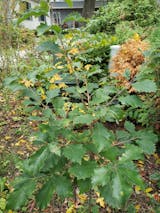






A HANDSOME SHADE TREE WITH A BUFFET OF ACORNS FOR THE BIRDS
FEATURES:
May Benefit & Attract: thrushes, waxwings, wood warblers, finches, mockingbirds & thrashers, chickadees & titmice, orioles, cardinals & grosbeaks, crows & jays, sparrows, nuthatches, vireos, hummingbirds, woodpeckers, and wrens
- A strong shade tree, flaunting brilliant yellows and oranges for fall color
- The acorns are a favorite snack amongst the local wildlife
- A vigorous, easy-to-grow tree; adaptable to most soil types
- This bird-friendly native plant provides food and shelter for local and migrating birds and other wildlife
- All Audubon® branded trees and plants are grown 100% Neonic-free by Bower & Branch, making these plants safer for the birds and safer for the environment
- The National Audubon Society protects birds and the places they need, today and tomorrow
- Hand Selected, Fresh from the Grower
- Ships in a plant-safe designed box
Growth Facts
- Hardiness Zone: 4-8
- Mature Height: 12-20' tall
- Mature Width: 12-20' wide
- Exposure: Full Sun
- Spacing: 12-20' apart
A HANDSOME SHADE TREE WITH A BUFFET OF ACORNS FOR THE BIRDS
FEATURES:
May Benefit & Attract: thrushes, waxwings, wood warblers, finches, mockingbirds & thrashers, chickadees & titmice, orioles, cardinals & grosbeaks, crows & jays, sparrows, nuthatches, vireos, hummingbirds, woodpeckers, and wrens
- A strong shade tree, flaunting brilliant yellows and oranges for fall color
- The acorns are a favorite snack amongst the local wildlife
- A vigorous, easy-to-grow tree; adaptable to most soil types
- This bird-friendly native plant provides food and shelter for local and migrating birds and other wildlife
- All Audubon® branded trees and plants are grown 100% Neonic-free by Bower & Branch, making these plants safer for the birds and safer for the environment
- The National Audubon Society protects birds and the places they need, today and tomorrow
- Hand Selected, Fresh from the Grower
- Ships in a plant-safe designed box
Growth Facts
- Hardiness Zone: 4-8
- Mature Height: 12-20' tall
- Mature Width: 12-20' wide
- Exposure: Full Sun
- Spacing: 12-20' apart
Why plant Audubon® Native Dwarf Chestnut Oak Treeling?
If you’re a bird lover, you may know that planting an oak tree is probably the best thing you can do to support your feathered friends. Oak Trees host literally hundreds of species of caterpillars and other insects, which in turn make up a vital part of many birds’ diets. The problem is, most oaks become massive in time—what do you do if you have a small yard? Enter Dwarf Chestnut Oak, a charming species that stays petite! This unusual, shrubby oak will give birds what they want, but it won’t take over your whole garden. Perfect!
Dwarf Chestnut Oak is a tenacious little survivor that thrives in sunny, dry, poor, rocky sites. It’s found over a vast range stretching from Oklahoma to New Hampshire, though it is rarely found in the middle of that range—in the Ohio Valley, where soils are too alkaline for its liking. Typically staying short and shrubby, Dwarf Chestnut Oak will make a thicket in time, which provides good nesting habitat for many songbirds. If suckers are removed promptly, it will become a tree, but not a very large one. The national champion, in New York State, is only 34 feet tall!
How to use Audubon® Native Dwarf Chestnut Oak Treeling in the landscape?
Acorns, too! Dwarf Chestnut Oak serves up acorns to hungry wildlife, like squirrels, blue jays, nuthatches, and woodpeckers. Its acorns are more palatable than those of most other species, and they are produced at a young age. Trees may start bearing them in only three to five years.
Audubon® Native Plants & Trees
Audubon is devoted to protecting birds and the places they need, while Bower & Branch is devoted to the growth of true native trees and plants–no cultivars or hybrids. Together, we strive to unite communities in conservation and inspire individuals to cultivate a better world for birds starting in their own backyards, balconies, or patios. By guiding and recommending trees and plants truly native and beneficial to your region, we can really start to make a difference.
What is the definition of Native?
“In the United States, a native plant is defined as one that was naturally found in a particular area before European colonization. Native plants are the foundation of a region’s biodiversity, providing essential food sources and shelter for birds, especially those threatened by the changing climate. Since native plants are adapted to local precipitation and soil conditions, they generally require less upkeep, therefore helping the environment and saving you time, water, and money.” – The National Audubon Society
Learn how you can help birds in your home and community through Audubon’s Plants for Birds program.
Audubon® is a licensed and registered trademark of the National Audubon Society. All rights reserved.
Planting Zones
Hardiness Zone: 4-8
How To Plant Audubon® Native Dwarf Chestnut Oak Treeling
Plant your Dwarf Chestnut Oak in an area that will receive full sun—this tree does not like shade at all. It also struggles in alkaline soils, and the leaves will become chlorotic (yellow) there. Choose this tree only if your soil is naturally acidic. Good drainage is important as well. If your soil stays soggy after a rain, you should select another type of Oak, such as Swamp White Oak or Overcup Oak. Little pruning will be necessary, but if you must prune, do so only between December and February. The fungal disease Oak Wilt can strike when Oaks are pruned during active growth.
How To Water
Water twice weekly for the first 3-5 weeks; then water weekly for the remainder of the year until winter. When you water, water slowly and thoroughly. Watering needs may be altered due to extreme weather conditions.
How To Fertilize
Incorporate Elements Starter Plant food granular form into the soil when planting. If planting in spring or summer, start fertilizing late fall using Elements Starter Plant food granular form on an annual basis each late fall. If planting in the fall, use Elements fertilizer while planting and start your regular annual fertilizing the following fall. Continue this for the first three years to get your plant well established as it gives your tree the nutrients it needs to produce lush new growth for the following spring.
How To Prune
A young tree may need a little extra support to ensure that it lives a long and healthy life. Stake your new Treeling with a 6-8 foot tall wood or bamboo stake. Use expandable ties that will stretch as the tree grows, fastening the stake to the main trunk from the base to the top. Check the ties every few months, at least twice a year; ensuring the ties are not digging into the trunk. If there is any sign of this, take the tie off and reattach it, giving the tree more room to grow.
As your tree grows, remove a few of the lower branches each year in mid to late summer. Remove these lower branches before they reach 1/2 inch in diameter. It is better to make small cuts to avoid cutting a large, more mature branch - this is too stressful for the tree. Each year, make any corrective pruning needed, paying particular attention to removing damaged branches, rubbing branches, multiple leaders at the top, or suckers at the base. Limit any pruning to no more than 25% of the branching structure in a given year. Pruning benefits the tree and helps to achieve a balanced tree form.
After two or three years you can feel free to remove the stake from the tree.
How Does Shipping Work?
Size Small (AAA), Medium (A2A), and Large (AA) plants (our Treelings, Shrubs, Bushes, and Perennials) will be shipped directly to your home by a common carrier. Ships in a plant-safe designed box within 5-7 business days.
How Does Sizing Work?
The size of our trees have nothing to do with the container size like you may find elsewhere–big doesn't mean just height - it’s also vigor, age, and overall health.. Other online retailers are going to tell you that a plant is a seven gallon, that means nothing to your tree or plant (or you.)
Our trees for sale online are graded on large, x-large, and even bigger sizes. This is because our trees are sized by their age—the higher the letter, the more mature the tree. The age determines the trees’ overall height, size of the trunk and the overall branch density.
All of these characteristics are what you should be looking for when choosing a tree for immediate impact and instant curb appeal. Our extra-large tree and plant sizes are sure to wow you and your neighbors!
See the size guides below.












